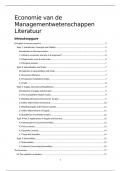Economie van de
Managementwetenschappen
Literatuur
Inhoudsopgave
Principles of microeconomics.................................................................................................................5
Topic 1: Introductory Concepts and Models.......................................................................................5
Introduction to Microeconomics....................................................................................................5
1.1 What is economics and why is it important?............................................................................6
1.2 Opportunity costs & sunk costs................................................................................................6
1.3 Marginal analysis......................................................................................................................7
Topic 2: Specialization and Trade........................................................................................................7
Introduction to specialization and trade.........................................................................................7
2.1 Economic efficiency..................................................................................................................7
2.2 Production Possibility Frontier..................................................................................................7
2.3 Trade.........................................................................................................................................8
Topic 3: Supply, Demand and Equilibrium...........................................................................................9
Introduction to Supply and Demand...............................................................................................9
3.1 The Competitive Market model................................................................................................9
3.2 Building Demand and Consumer Surplus..................................................................................9
3.3 Other Determinant of Demand...............................................................................................10
3.4 Building Supply and Producer Surplus....................................................................................11
3.5 Other Determinants of Supply................................................................................................11
3.6 Equilibrium and Market Surplus..............................................................................................12
Topic 4 Part 2: Applications of Supply and Demand..........................................................................12
4.4 Introduction to Government Policy.........................................................................................12
4.5 Price controls..........................................................................................................................13
4.6 Quantity Controls....................................................................................................................14
4.7 Taxes and Subsidies.................................................................................................................14
Topic 5: Externalities.........................................................................................................................15
5.1 Externalities............................................................................................................................15
5.2 Indirectly Correcting Externalities...........................................................................................16
The Economy........................................................................................................................................17
H1 The capitalist revolution..............................................................................................................17
1
, 1.1 Income inequality...................................................................................................................17
1.2 Measuring income and living standards..................................................................................17
1.3 History’s hockey stick: Growth in income................................................................................18
1.8 The gains from specialization..................................................................................................18
H3 Scarcity, work and choice............................................................................................................19
3.3 Opportunity costs...................................................................................................................19
H4 Social Interactions.......................................................................................................................19
Introduction..................................................................................................................................19
4.1 Social Interactions: Game Theory...........................................................................................19
4.2 Equilibrium in the invisible hand game...................................................................................19
4.3 The prisoners’ dilemma..........................................................................................................20
4.4 Social preferences: altruism....................................................................................................20
4.5 Altruistic preferences in the prisoners’ dilemma....................................................................20
4.6 Public goods, free riding, and repeated interaction................................................................20
4.7 Public good contributions and peer punishment....................................................................20
4.8 Behavioural experiments in the lab and in the field................................................................21
4.9 Cooperation negotiation, conflicts of interest, and social norms............................................21
H6 The firm: owners, managers and employees...............................................................................21
6.10 Principles and agents: Interactions under incomplete contracts..........................................21
H7 The firm and its customers..........................................................................................................22
7.6 Looking at profit maximization as marginal revenue and marginal cost.................................22
H8 Supply and demand: Price-taking and competitive markets.......................................................22
8.1 Buying and selling: demand and supply..................................................................................22
8.2 The market and the equilibrium price.....................................................................................22
8.4 Market supply and equilibrium...............................................................................................23
8.5 Competitive equilibrium: gains from trade, allocation, and distribution................................23
8.6 Changes in supply and demand..............................................................................................23
8.7 The effects of taxes.................................................................................................................23
H10 Banks, money and the credit market.........................................................................................24
10.8 Banks, money and the central bank......................................................................................24
10.12 Credit market constraints: a principal-agent problem........................................................25
H12 Markets, efficiency, and public policy........................................................................................26
12.1 Market failure: external effects of pollution.........................................................................26
12.2 External effects and bargaining.............................................................................................26
12.3 External effects: policies and income distribution................................................................26
12.4 Property rights, contracts, and market failures.....................................................................27
2
, 12.5 Public goods..........................................................................................................................27
12.6 Missing markets: insurance and lemons...............................................................................28
12.8 The limits of markets............................................................................................................28
12.9 Market failure and government policy..................................................................................28
H17 Capstone: the Great Depression, golden age and global financial crisis....................................29
17.8 Before the financial crisis: households, banks and the credit boom.....................................29
17.10 The financial crisis and the great recession.........................................................................31
17.11 The role of banks in the crisis..............................................................................................31
H18 Capstone: The nation and the world economy..........................................................................32
Introduction..................................................................................................................................32
18.1 Globalization and deglobalization in the long run.................................................................32
18.2 Globalization and investment...............................................................................................33
18.3 Globalization and migration..................................................................................................34
18.4 Specialization and the gains from trade among nations.......................................................34
18.5 Specialization, factor endowments, and trade between countries.......................................34
18.6 Winners and losers from trade and specialization................................................................35
18.7 Winners and losers in the very long run and along the way.................................................35
18.8 Migration: Globalization of labour........................................................................................35
18.9 Globalization and anti-globalization......................................................................................35
18.10 Trade and growth................................................................................................................36
18.11 Conclusion..........................................................................................................................37
H19 Economic inequality..................................................................................................................37
19.1 Inequality across the world and over time............................................................................37
19.2. Accidents of birth: Another lens to study inequality............................................................39
19.3 What (if anything) is wrong with inequality?........................................................................39
19.4 How much inequality is too much (or too little)?..................................................................39
19.5 Endowments, technology, and institutions...........................................................................40
H20 Economics of the environment..................................................................................................41
20.1 Recap: External effects, incomplete contracts, and missing markets....................................41
20.2 Climate change.....................................................................................................................41
20.3 The abatement of environmental damages: Cost-benefit analysis.......................................42
20.4 Conflicts of interest: Bargaining over wages, pollution, and jobs..........................................43
20.5 Cap and trade environmental policies..................................................................................43
20.6 The measurement challenges of environmental policy.........................................................44
20.7 Dynamic environmental policies: Future technologies and lifestyles....................................45
20.8 Environmental dynamics.......................................................................................................45
3
, 20.9 Why is addressing climate change so difficult?.....................................................................46
20.10 Policy choices matter..........................................................................................................47
H21 Innovation, information, and the networked economy.............................................................47
21.1 The innovation process: invention and diffusion..................................................................47
21.2 Innovation systems...............................................................................................................48
21.3 External effects: complements, substitutes and coordination..............................................50
21.4 Economies of scale and winner-take-all competition............................................................50
Economy, Society and Public Policy......................................................................................................52
H1 Capitalism and democracy: Affluence, inequality, and the environment....................................52
1.1 Introduction............................................................................................................................52
1.2 Affluence and income inequality............................................................................................52
1.3 How did we get here? The hockey stick in real incomes.........................................................52
1.4 Economic growth....................................................................................................................52
1.5 The permanent technological revolution: Engine of growth...................................................53
1.6 Another engine of growth: More machines and tools per worker..........................................53
1.7 The capitalist revolution..........................................................................................................53
1.8 Capitalism and growth: Cause and effect?..............................................................................54
1.9 Varieties of capitalism: Institutions and growth......................................................................55
1.10 Varieties of capitalism: Growth and stagnation....................................................................55
1.11 Capitalism, inequality, and democracy..................................................................................55
1.12 Capitalism, growth and environmental sustainability...........................................................56
1.13 Conclusion............................................................................................................................56
H6 The firm: Employees, managers, and owners..............................................................................56
6.2 Firms, markets, and the division of labour..............................................................................56
6.3 Power relations within the firm..............................................................................................57
6.4 Other people’s money: the separation of ownership and control..........................................57
6.5 Other people’s labour: the employment relationship.............................................................58
H10 Banks, money, housing and financial assets..............................................................................59
10.12 Banks, housing and the global crisis....................................................................................59
10.13 The role of banks in the crisis..............................................................................................59
H12 Governments and markets in a democratic society...................................................................59
12.3 The government as an economic actor.................................................................................59
12.4 The government as a rent-seeking monopolist.....................................................................60
12.5 Competition can limit political rent-seeking.........................................................................61
12.6 Political monopoly and competition compared....................................................................61
12.7 Spending by democratic governments: priorities of a nation...............................................61
4




